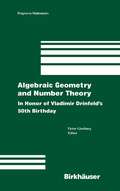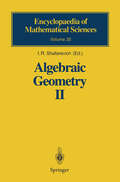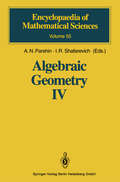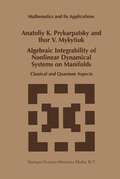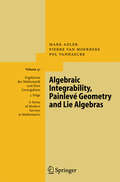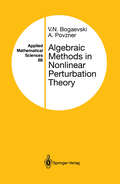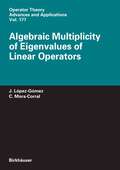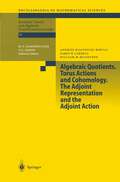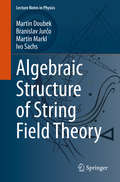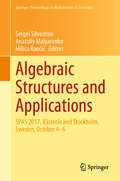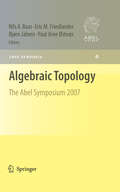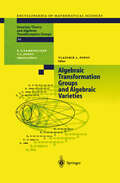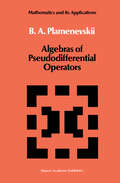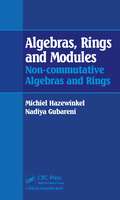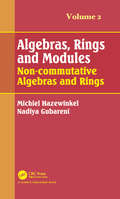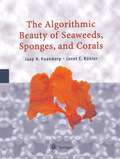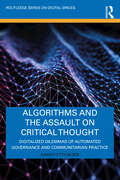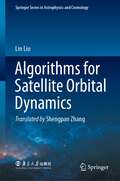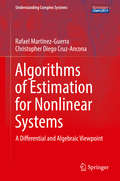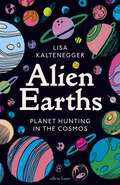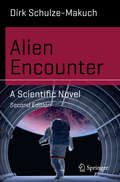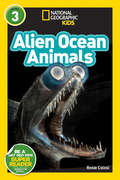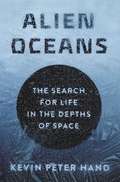- Table View
- List View
Algebraic Geometry and Number Theory: In Honor of Vladimir Drinfeld's 50th Birthday (Progress in Mathematics #253)
by Victor GinzburgThis book represents a collection of invited papers by outstanding mathematicians in algebra, algebraic geometry, and number theory dedicated to Vladimir Drinfeld. Original research articles reflect the range of Drinfeld's work, and his profound contributions to the Langlands program, quantum groups, and mathematical physics are paid particular attention. These ten original articles by prominent mathematicians, dedicated to Drinfeld on the occasion of his 50th birthday, broadly reflect the range of Drinfeld's own interests in algebra, algebraic geometry, and number theory.
Algebraic Geometry II: Cohomology of Algebraic Varieties. Algebraic Surfaces (Encyclopaedia of Mathematical Sciences #35)
by V. I. Danilov V. A. Iskovskikh I. R. ShafarevichThis two-part volume contains numerous examples and insights on various topics. The authors have taken pains to present the material rigorously and coherently. This book will be immensely useful to mathematicians and graduate students working in algebraic geometry, arithmetic algebraic geometry, complex analysis and related fields.
Algebraic Geometry IV: Linear Algebraic Groups Invariant Theory (Encyclopaedia of Mathematical Sciences #55)
by V. L. Popov T. A. Springer E. B. VinbergTwo contributions on closely related subjects: the theory of linear algebraic groups and invariant theory, by well-known experts in the fields. The book will be very useful as a reference and research guide to graduate students and researchers in mathematics and theoretical physics.
Algebraic Integrability of Nonlinear Dynamical Systems on Manifolds: Classical and Quantum Aspects (Mathematics and Its Applications #443)
by A.K. Prykarpatsky I.V. MykytiukIn recent times it has been stated that many dynamical systems of classical mathematical physics and mechanics are endowed with symplectic structures, given in the majority of cases by Poisson brackets. Very often such Poisson structures on corresponding manifolds are canonical, which gives rise to the possibility of producing their hidden group theoretical essence for many completely integrable dynamical systems. It is a well understood fact that great part of comprehensive integrability theories of nonlinear dynamical systems on manifolds is based on Lie-algebraic ideas, by means of which, in particular, the classification of such compatibly bi Hamiltonian and isospectrally Lax type integrable systems has been carried out. Many chapters of this book are devoted to their description, but to our regret so far the work has not been completed. Hereby our main goal in each analysed case consists in separating the basic algebraic essence responsible for the complete integrability, and which is, at the same time, in some sense universal, i. e. , characteristic for all of them. Integrability analysis in the framework of a gradient-holonomic algorithm, devised in this book, is fulfilled through three stages: 1) finding a symplectic structure (Poisson bracket) transforming an original dynamical system into a Hamiltonian form; 2) finding first integrals (action variables or conservation laws); 3) defining an additional set of variables and some functional operator quantities with completely controlled evolutions (for instance, as Lax type representation).
Algebraic Integrability, Painlevé Geometry and Lie Algebras (Ergebnisse der Mathematik und ihrer Grenzgebiete. 3. Folge / A Series of Modern Surveys in Mathematics #47)
by Mark Adler Pierre van Moerbeke Pol VanhaeckeAlgebraic Methods in Nonlinear Perturbation Theory (Applied Mathematical Sciences #88)
by V.N. Bogaevski A. PovznerOf interest to everybody working on perturbation theory in differential equations, this book requires only a standard mathematical background in engineering and does not require reference to the special literature. Topics covered include: matrix perturbation theory; systems of ordinary differential equations with small parameters; reconstruction and equations in partial derivatives. While boundary problems are not discussed, the book is clearly illustrated by numerous examples.
Algebraic Multiplicity of Eigenvalues of Linear Operators (Operator Theory: Advances and Applications #177)
by Julián López-Gómez Carlos Mora-CorralThis book brings together all available results about the theory of algebraic multiplicities. It first offers a classic course on finite-dimensional spectral theory and then presents the most general results available about the existence and uniqueness of algebraic multiplicities for real non-analytic operator matrices and families. Coverage next transfers these results from linear to nonlinear analysis.
Algebraic Quotients. Torus Actions and Cohomology. The Adjoint Representation and the Adjoint Action (Encyclopaedia of Mathematical Sciences #131)
by A. Bialynicki-Birula J. Carrell W.M. McGovernThis is the second volume of the new subseries "Invariant Theory and Algebraic Transformation Groups". The aim of the survey by A. Bialynicki-Birula is to present the main trends and achievements of research in the theory of quotients by actions of algebraic groups. This theory contains geometric invariant theory with various applications to problems of moduli theory. The contribution by J. Carrell treats the subject of torus actions on algebraic varieties, giving a detailed exposition of many of the cohomological results one obtains from having a torus action with fixed points. Many examples, such as toric varieties and flag varieties, are discussed in detail. W.M. McGovern studies the actions of a semisimple Lie or algebraic group on its Lie algebra via the adjoint action and on itself via conjugation. His contribution focuses primarily on nilpotent orbits that have found the widest application to representation theory in the last thirty-five years.
Algebraic Structure of String Field Theory (Lecture Notes in Physics #973)
by Martin Doubek Branislav Jurčo Martin Markl Ivo SachsThis book gives a modern presentation of modular operands and their role in string field theory. The authors aim to outline the arguments from the perspective of homotopy algebras and their operadic origin. Part I reviews string field theory from the point of view of homotopy algebras, including A-infinity algebras, loop homotopy (quantum L-infinity) and IBL-infinity algebras governing its structure. Within this framework, the covariant construction of a string field theory naturally emerges as composition of two morphisms of particular odd modular operads. This part is intended primarily for researchers and graduate students who are interested in applications of higher algebraic structures to strings and quantum field theory. Part II contains a comprehensive treatment of the mathematical background on operads and homotopy algebras in a broader context, which should appeal also to mathematicians who are not familiar with string theory.
Algebraic Structures and Applications: SPAS 2017, Västerås and Stockholm, Sweden, October 4-6 (Springer Proceedings in Mathematics & Statistics #317)
by Sergei Silvestrov Anatoliy Malyarenko Milica RančićThis book explores the latest advances in algebraic structures and applications, and focuses on mathematical concepts, methods, structures, problems, algorithms and computational methods important in the natural sciences, engineering and modern technologies. In particular, it features mathematical methods and models of non-commutative and non-associative algebras, hom-algebra structures, generalizations of differential calculus, quantum deformations of algebras, Lie algebras and their generalizations, semi-groups and groups, constructive algebra, matrix analysis and its interplay with topology, knot theory, dynamical systems, functional analysis, stochastic processes, perturbation analysis of Markov chains, and applications in network analysis, financial mathematics and engineering mathematics. The book addresses both theory and applications, which are illustrated with a wealth of ideas, proofs and examples to help readers understand the material and develop new mathematical methods and concepts of their own. The high-quality chapters share a wealth of new methods and results, review cutting-edge research and discuss open problems and directions for future research. Taken together, they offer a source of inspiration for a broad range of researchers and research students whose work involves algebraic structures and their applications, probability theory and mathematical statistics, applied mathematics, engineering mathematics and related areas.
Algebraic Topology: The Abel Symposium 2007 (Abel Symposia #4)
by Nils Baas Eric Friedlander Bjö Jahren Paul Arne ØstværThe 2007 Abel Symposium took place at the University of Oslo in August 2007. The goal of the symposium was to bring together mathematicians whose research efforts have led to recent advances in algebraic geometry, algebraic K-theory, algebraic topology, and mathematical physics. A common theme of this symposium was the development of new perspectives and new constructions with a categorical flavor. As the lectures at the symposium and the papers of this volume demonstrate, these perspectives and constructions have enabled a broadening of vistas, a synergy between once-differentiated subjects, and solutions to mathematical problems both old and new.
Algebraic Transformation Groups and Algebraic Varieties: Proceedings of the conference Interesting Algebraic Varieties Arising in Algebraic Transformation Group Theory held at the Erwin Schrödinger Institute, Vienna, October 22–26, 2001 (Encyclopaedia of Mathematical Sciences #132)
by Vladimir Leonidovich PopovThe book covers topics in the theory of algebraic transformation groups and algebraic varieties which are very much at the frontier of mathematical research.
Algebras of Pseudodifferential Operators (Mathematics and its Applications #43)
by B.A. PlamenevskiiAlgebras, Rings and Modules: Non-commutative Algebras and Rings
by Michiel Hazewinkel Nadiya M. GubareniThe theory of algebras, rings, and modules is one of the fundamental domains of modern mathematics. General algebra, more specifically non-commutative algebra, is poised for major advances in the twenty-first century (together with and in interaction with combinatorics), just as topology, analysis, and probability experienced in the twentieth centu
Algebras, Rings and Modules, Volume 2: Non-commutative Algebras and Rings
by Michiel Hazewinkel Nadiya M. GubareniThe theory of algebras, rings, and modules is one of the fundamental domains of modern mathematics. General algebra, more specifically non-commutative algebra, is poised for major advances in the twenty-first century (together with and in interaction with combinatorics), just as topology, analysis, and probability experienced in the twentieth century. This is the second volume of Algebras, Rings and Modules: Non-commutative Algebras and Rings by M. Hazewinkel and N. Gubarenis, a continuation stressing the more important recent results on advanced topics of the structural theory of associative algebras, rings and modules.
Algebras, Rings and Modules, Volume 2: Non-commutative Algebras and Rings
by Michiel Hazewinkel Nadiya M. GubareniThe theory of algebras, rings, and modules is one of the fundamental domains of modern mathematics. General algebra, more specifically non-commutative algebra, is poised for major advances in the twenty-first century (together with and in interaction with combinatorics), just as topology, analysis, and probability experienced in the twentieth century. This is the second volume of Algebras, Rings and Modules: Non-commutative Algebras and Rings by M. Hazewinkel and N. Gubarenis, a continuation stressing the more important recent results on advanced topics of the structural theory of associative algebras, rings and modules.
The Algorithmic Beauty of Seaweeds, Sponges and Corals (The Virtual Laboratory)
by Jaap A. Kaandorp Janet E. KüblerWith contributions by E.Abraham, D.Barnes, R.Carpenter, L.Collado, P.Dodds, S.Dudgeon, D.Garbary, S.Gatti, B.Helmuth, M.R.Koehl, H.Lasker, R.Merks., W.Müller, S.Muko, B. Rinkevich, J.Sanchez, P.Sloot, M.Vermeij
Algorithms and the Assault on Critical Thought: Digitalized Dilemmas of Automated Governance and Communitarian Practice (Routledge Series on Digital Spaces)
by Nancy EttlingerThis book examines the digitalization of longstanding problems of technological advance that produce inequalities and automated governance, which relieves subjects of agency and critical thought, and prompts a need to weaponize thoughtfulness against technocratic designs. The book situates digital-era problems relative to those of previous sociotechnical milieux and argues that technical advance perennially embeds corrosive effects on social relations and relations of production, recognizing variation across contexts and relative to entrenched societal hierarchies of race and other axes of difference and their intersections. Societal tolerance, despite abundant evidence for harmful effects of digital technologies, requires attention. The book explains blindness to social injustice by technocratic thinking delivered through education as well as truths embraced in the data sciences coupled with governance in universities and the private sector that protect these truths from critique. Institutional inertia suggests benefits of communitarianism, which strives for change emanating from civil society. Scaling postcapitalist communitarian values through communitybased peer production presents opportunities. However, enduring problems require critical reflection, continual revision of strategies, and active participation among diverse community citizens. This book is written with critical geographic sensibilities for an interdisciplinary audience of scholars and graduate and undergraduate students in the social sciences, humanities, and data sciences.
Algorithms and the Assault on Critical Thought: Digitalized Dilemmas of Automated Governance and Communitarian Practice (Routledge Series on Digital Spaces)
by Nancy EttlingerThis book examines the digitalization of longstanding problems of technological advance that produce inequalities and automated governance, which relieves subjects of agency and critical thought, and prompts a need to weaponize thoughtfulness against technocratic designs. The book situates digital-era problems relative to those of previous sociotechnical milieux and argues that technical advance perennially embeds corrosive effects on social relations and relations of production, recognizing variation across contexts and relative to entrenched societal hierarchies of race and other axes of difference and their intersections. Societal tolerance, despite abundant evidence for harmful effects of digital technologies, requires attention. The book explains blindness to social injustice by technocratic thinking delivered through education as well as truths embraced in the data sciences coupled with governance in universities and the private sector that protect these truths from critique. Institutional inertia suggests benefits of communitarianism, which strives for change emanating from civil society. Scaling postcapitalist communitarian values through communitybased peer production presents opportunities. However, enduring problems require critical reflection, continual revision of strategies, and active participation among diverse community citizens. This book is written with critical geographic sensibilities for an interdisciplinary audience of scholars and graduate and undergraduate students in the social sciences, humanities, and data sciences.
Algorithms for Satellite Orbital Dynamics (Springer Series in Astrophysics and Cosmology)
by Lin LiuThis book highlights the fundamental physics of orbit theory, dynamical models, methods of orbit determination, design, measurement, adjustment, and complete calculations for the position, tracking, and prediction of satellites and deep spacecraft. It emphasizes specific methods, related mathematical calculations, and worked examples and exercises. Therefore, technicians and engineers in the aerospace industry can directly apply them to their practical work. Dedicated to undergraduate students and graduate students, researchers, and professionals in astronomy, physics, space science, and related aerospace industries, the book is an integrated work based on the accumulated knowledge in satellite orbit dynamics and the author’s more than five decades of personal research and teaching experience in astronomy and aerospace dynamics.
Algorithms of Estimation for Nonlinear Systems: A Differential and Algebraic Viewpoint (Understanding Complex Systems)
by Rafael Martínez-Guerra Christopher Diego Cruz-AnconaThis book acquaints readers with recent developments in dynamical systems theory and its applications, with a strong focus on the control and estimation of nonlinear systems. Several algorithms are proposed and worked out for a set of model systems, in particular so-called input-affine or bilinear systems, which can serve to approximate a wide class of nonlinear control systems. These can either take the form of state space models or be represented by an input-output equation. The approach taken here further highlights the role of modern mathematical and conceptual tools, including differential algebraic theory, observer design for nonlinear systems and generalized canonical forms.
Alien Earths: Planet Hunting in the Cosmos
by Lisa Kaltenegger‘Lisa Kaltenegger offers first-hand access to her expertise on the search for planets in the universe, and the life they may contain. Along the way, Lisa's breezy narrative style invites you to experience with her the challenges and joys of being a scientist on the frontier of discovery’ Neil deGrasse Tyson, AstrophysicistFor thousands of years, humans have wondered whether we're alone in the cosmos. Now, for the first time, we have the technology to investigate. The question should have an obvious answer: yes or no. But once you try to find life elsewhere, you realize it is not so simple. How do you find it over cosmic distances? What actually is life?Astronomer Lisa Kaltenegger works from Carl Sagan’s former office at Cornell University, where she built a team of tenacious scientists from many disciplines to find life on faraway worlds, using Earth’s diverse biosphere and its history as a Rosetta Stone. With infectious enthusiasm, she provides an eye-opening insider’s guide to the most unusual exoplanets that have shaken our worldview – planets covered in oceans of lava, lonely wanderers lost in space, and others with more than one sun in their sky – as well as the best contenders for Alien Earths. She also shows how close imagined scifi worlds come to reality.We live in an incredible new epoch of exploration. As our witty and knowledgeable tour guide, Professor Kaltenegger shows how we discover not merely new continents, like the explorers of old, but whole new worlds circling other stars – and how we could spot life there. Worlds from where aliens may even be gazing back at us. What if we're not alone?
Alien Encounter: A Scientific Novel (Science and Fiction)
by Dirk Schulze-MakuchIt has been nearly 100 years since the Apollo moon landings, when Jack and Vladimir, two astronauts on a mission to Venus, discover a mysterious void related to indigenous life on the planet. Subsequently more voids are detected on Earth, Mars, Titan, and, quite ominously, inside a planetoid emerging from the Kuiper belt.Jack is sent to investigate the voids in the Solar System and intercept the planetoid - which, as becomes increasingly clear, is inhabited by alien life forms. Jack and his crew will have little time to understand their alien biochemistry, abilities, behavior patterns, resilience, and technology, but also how these life forms relate to the voids.Humankind's first encounter with these exotic life forms couldn't be more fateful, becoming a race against time to save life on Earth and to reveal the true nature of the voids, which seem to be intrinsically related to life and the universe itself. In this novel, the author combines many topics related to state-of-the-art research in the field of astrobiology with fictional elements to produce a thrilling page turner.This new version significantly develops the astrobiological denouement of the plot and features an extensive non-technical appendix where the underlying science is presented and discussed.From the reviews of the first edition (Voids of Eternity: Alien Encounter)Here's a thrilling yarn in the best "hard SF" tradition of Asimov, James Hogan, and Ben Bova, written by a scientist who knows all about the possibilities of life in the solar system and beyond. Dirk Schulze-Makuch weaves into his book all the astrobiological themes he's worked on in recent years -- speculation about creatures in the atmosphere of Venus and on and under the surface of Mars and Titan -- together with some well-informed Eastern philosophy and a cracking good space battle. A great first novel from a rising talent. Highly recommended. David Darling, on amazon.com, 2009The research interests of Dr. Schulze-Makuch, currently a professor at Washington State University, focus on evolutionary adaptation strategies of organisms in their natural environment, particularly extreme environments such as found on other planetary bodies. Dirk Schulze-Makuch is best known for his publications on extraterrestrial life, being coauthor of three books on the topic: We Are Not Alone: Why We Have Already Found Extraterrestrial Life (2010), Cosmic Biology: How Life could Evolve on Other Worlds (2010), and Life in the Universe: Expectations and Constraints (2004). In 2011 he published with Paul Davies A One Way Mission to Mars: Colonizing the Red Planet and in 2012 with David Darling Megacatastrophes! Nine Strange Ways the World Could End.
Alien Ocean Animals (National Geographic Readers)
by National Geographic Kids Rosie ColosiAre these strange animals the stuff of nightmares or aliens from outer space? Turns out, they're real undersea animals! Find out how deep sea creatures use bizarre and fascinating adaptations to survive in their harsh environments in this Level 3 Reader.
Alien Oceans: The Search for Life in the Depths of Space
by Kevin HandInside the epic quest to find life on the water-rich moons at the outer reaches of the solar systemWhere is the best place to find life beyond Earth? We often look to Mars as the most promising site in our solar system, but recent scientific missions have revealed that some of the most habitable real estate may actually lie farther away. Beneath the frozen crusts of several of the small, ice-covered moons of Jupiter and Saturn lurk vast oceans that may have been in existence for as long as Earth, and together may contain more than fifty times its total volume of liquid water. Could there be organisms living in their depths? Alien Oceans reveals the science behind the thrilling quest to find out.Kevin Peter Hand is one of today's leading NASA scientists, and his pioneering research has taken him on expeditions around the world. In this captivating account of scientific discovery, he brings together insights from planetary science, biology, and the adventures of scientists like himself to explain how we know that oceans exist within moons of the outer solar system, like Europa, Titan, and Enceladus. He shows how the exploration of Earth's oceans is informing our understanding of the potential habitability of these icy moons, and draws lessons from what we have learned about the origins of life on our own planet to consider how life could arise on these distant worlds.Alien Oceans describes what lies ahead in our search for life in our solar system and beyond, setting the stage for the transformative discoveries that may await us.
